As Shakespeare once wrote “Of all flowers, methinks rose is best” and we couldn’t agree more. The rose is one of the oldest flowers in cultivation, beloved by humans for millennia. Beauty, elegance, versatility, fragrance, the rose has it all. Rose blooms come in so many different sizes, shapes, and colours and they have many different uses that it’s impossible to imagine a world without them. Rose colour is one of the most important things to consider while thinking about roses.
Red roses receive the most love and they are frequently used to symbolize this beautiful feeling, but these flowers are so much more than just a Valentine’s Day symbol. Roses belong to the Rosaceae family of plants and the Rosa genus, which contains approximately 150 different species. This means that there are over 150 different types of roses that you can grow in your garden, on your balcony, and even indoors. Some are climbers, some are shrubs, and some are really small and can be grown in small containers. The important thing is that they all deserve our attention.
So read this article if you want to find out more about roses, their history, their many uses, and which ones will thrive in your garden.
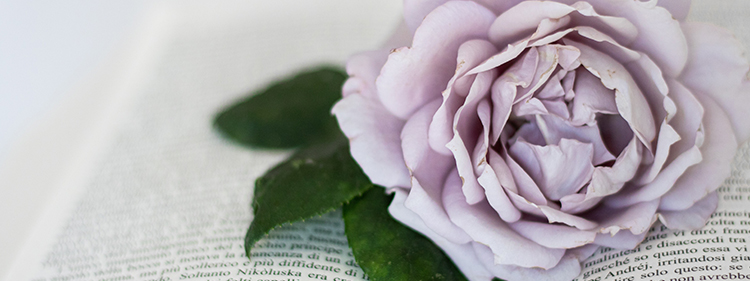
Short History of Roses
The passion that humans have for these beautiful flowers spans millennia. The rose is considered one of the most ancient flowers with the older fossil records of a rose flower dating back to 35 million years ago.
From a geographical perspective, roses can be grouped in two categories:
European/Mediterranean Roses (Centifolia, Alba, Gallica, etc) and Oriental roses (China and Tea Roses).
Records suggest that humans began the cultivation of roses 5000 years ago in China and thanks to their beauty they spread quickly all over the civilized world. In 500 B.C., Confucius wrote about the cultivation of roses in the Imperial Gardens and was impressed by the emperor’s collection of books on this topic. The members of the Han dynasty were so fascinated with roses that they put their own food supply at risk by cultivating these flowers excessively to the detriment of vital crops.
Roses were also found in 5th-century Egyptian tombs, and specialists believe that Cleopatra loved roses so much that she had her fountain filled with rose water. Persian King Nebuchadnezzar was no stranger to roses either, as he slept on a mattress filled with rose petals. Naturally, centuries later, roses had become a symbol of love, beauty, passion, and purity, beloved by Roman emperors, who sometimes forced peasants to grow these flowers instead of food.
Paganism
Christians considered rose flowers a symbol of paganism for a while, probably because the Romans had such an obsession with them. But, their warnings and bans were eventually ignored, as people continued to grow roses and to enjoy their beauty. Eventually, the rose started to be used in religious ceremonies, its popularity increased once more, and it became an important part of culture and literature.
Napoleon’s wife, Josephine, played an important role in the rich history of the rose, as she established one of the first large collections of roses at Chateau de Malmaison. She had over 250 varieties of roses in the gardens of her palace, most of them being European/Mediterranean.
The China Rose (Rosa chinensis) was introduced to Europe in the 18th century, and botanists started to cross it with Rosa gigantea, thus producing the spectacular hybrid – the Tea Rose. A few decades later, botanists created a new type of rose by crossing the lovely Damask rose with other species of roses, thus creating an industry that brought us the lovely varieties of roses that we can grow in our gardens today.
Types of Roses
Roses grow in almost all climates, from the arctic, Rosa laxa to the and steppes of Mongolia Rosa acicularis and on to the arid regions of Persia, Afghanistan and Turkestan Rosa persica There are also species that like to grow in moist swampy area such as Rosa palustrus and hundreds of species that grow all over the world in all types of climates from arctic to tropical..
Before we talk about all the different uses of roses, which of them are more popular, and what you should consider planting in your garden, it is important to note what the main types are. To make things easy for you, we’ll talk about a classification scheme approved by the American Rose Society. This handy classification aims to reflect how the rose plant has evolved over the years. So, the three main types of roses are:
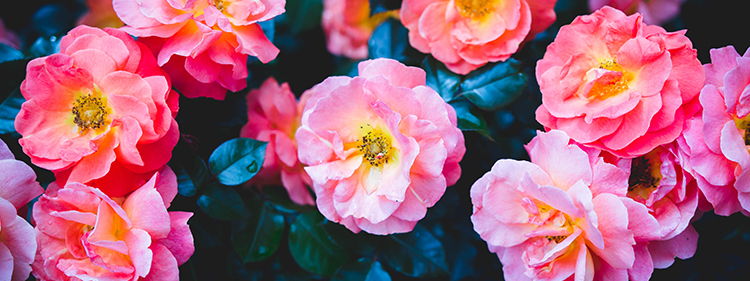
Species Roses
Although you might not be familiar with the term ‘species roses’, you have surely seen them around plenty of times. However did you know there are generally considered to be more than 300 species in 4-sub-genus? Commonly referred to as wild roses, the roses that belong to the ‘Species’ category are single-petalled (have between 4 and 8 petals) and grow as bushes that range in size from 0.5 to 6 meters.
Species roses are labelled according to their Latin name which begins with the letter R. that means Rosa, followed by a second term that describes them such as foetida, canina, chinensis, etc. Species roses can also be found labelled by their common names. For instance, you can find R. foetida bicolour as ‘Austrian Copper’, R. canina as ‘Dog Rose’, R. chinensis as ‘China Rose’, and so on.
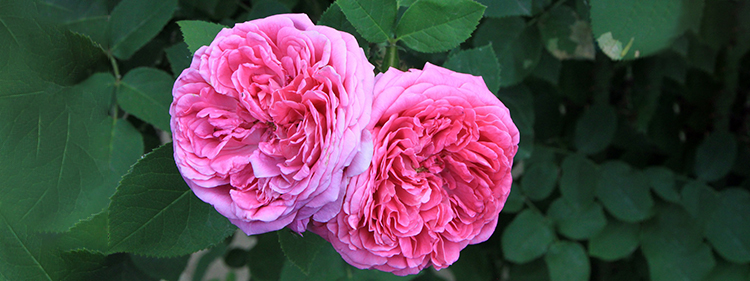
Old Garden Roses
The roses from this grouping are all the classes of garden roses that existed before 1867, the year in which ‘La France’ the very first hybrid tea was created by combining the Tea rose ‘Madame Bravy’ and the Hybrid Perpetual ‘Madame Victor Verdier’.
The ‘Old Garden Roses’ category was introduced in 1966, by the American Rose Society and it includes many subdivisions. An old garden rose can have a compact, cupped, expanded, quartered, imbricated, globular, or reflexed cup. Some varieties of old garden roses are once-bloomers and some are repeat-bloomers.
And, as if things weren’t complicated enough, there are two subclasses of Old Garden Roses: Antique and Old Roses.
Antique roses
Antique roses are those roses that originate from the Chinese Rose (R. Chinensis), the first repeat-bloomer that was introduced to Europe and the Western World in 1792. The main types of Antique roses are Bourbon, China, Hybrid Perpetual, Noisette, and Tea.
Old Roses
Old Roses on the other hand, are those roses that were found on the European continent until the aforementioned R. Chinensis was introduced. The most common types of Old Roses are Alba, Centifolia, Damask, Gallica, Moss, Portland, and Rambler.
The easiest way to tell them apart is by checking their blooming habit. Once-bloomers are generally Old Roses, and repeat-bloomers are probably Antique Roses.
It is safe to say that the arrival of the Chinese Rose in Europe has had a huge impact on the cultivation of roses because from then on, people were able to create all sorts of hybrids that bloomed repeatedly and, thus, had more aesthetic value, paving the way for the next category.
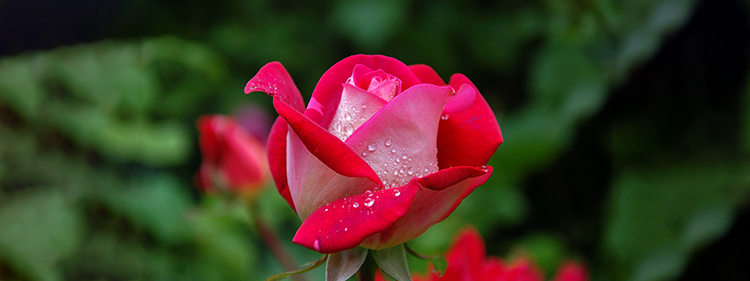
Modern Roses
The era of Modern Roses began with the introduction of ‘La France’ – the first hybrid tea rose, which was created by the French rose breeder Guillot. La France was the perfect combination between a hybrid perpetual and a tea rose that produced beautiful flowers. Beloved by many, this rose was such a success that by the end of the 20th century, breeders had already produced more than 10,000 hybrid tea varieties. If you’ve ever received a beautiful red rose, then you are already familiar with the Hybrid Tea. Elegant, hardy and with a long blooming period, Hybrid Teas are probably the most popular roses or even the most popular flowers on the planet.
The introduction of ‘La France’ was a revelation of sorts, after which specialists understood that they could successfully create roses with more convenient growth habits, unique colours, and luxurious blooms. The most common types of modern roses include Canadian Hardy, Climbing, English (David Austin) Floribunda, Grandiflora, Hybrid Tea, Landscape (Ground Cover), Miniature, Pernetiana, Patio, Polyantha, and Shrub Roses.
Rick Sauder from Summerland Ornamental Gardens is a Rosarian and had the following comments. “modern hybridizers around the world have used many of the species roses for decades to select for various characteristics such as repeat bloom, fragrance, disease resistance, cold hardiness, heat tolerance and the list goes on. The roses thus hybridized have then been crossed and re-crossed by breeders to produce the thousands of rose varieties available to gardeners and growers around the world. Roses for everyone, everywhere so to speak.”
Different Uses for Roses
People have had a special relationship with roses for thousands of years. Thanks to their versatility and multitude of uses, these beautiful flowers have inspired poems and works of art. Some roses have a fantastic fragrance that makes them a key ingredient in many beauty products and perfumes, and some have tasty petals that are valued in the culinary world. Let’s take a look at some of the most interesting and important uses that people have found for the members of the Rosa genus.
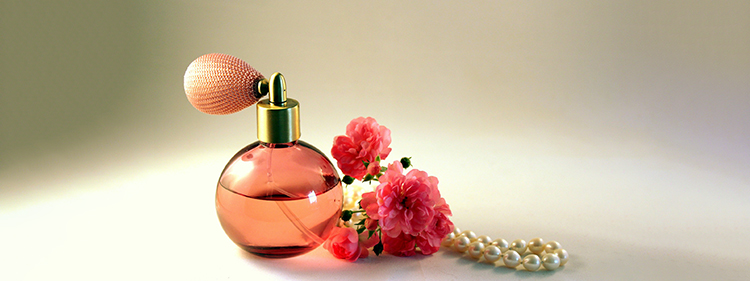
Beauty
As mentioned above, the Egyptians were big fans of roses, especially Cleopatra who was in love with rosewater. This beauty product is a great moisturizer, it hydrates and revitalizes the skin, it is rich in antioxidants, and it has antibacterial properties. Rosewater has many health benefits. It is a great treatment for skin irritations, cuts and bruises, skin redness, burns, and even sore throats and headaches.
Rosewater can easily be obtained from roses, even from the ones that you grow in your garden. The important thing here is to avoid using roses that have been treated with pesticides or that are growing in contaminated or heavily polluted areas.
How to make Rosewater
There are two different ways to obtain rosewater: simmering and distillation. The easiest way is through simmering and it consists of mixing 1 ½ cups of water with ½ cup of fresh rose petals. The next step is to simmer the rose petals until they turn pale and start to lose their colour. The whole process shouldn’t take more than 10 minutes. Remove the rose petals, let the rosewater cool down and store it in the refrigerator for up to two weeks.
The second method is known as distillation and it is a more difficult process. Frequently used in the beauty industry, this process is the true way to obtain high-quality rose water. The rosewater that’s obtained through distillation can last up to six months in the fridge. You can find detailed recipes for both simmered and distilled rose water here.
Rosewater is the star of the show when it comes to beauty products, but there are so many different rose-based products on the market that it would be difficult to name them all. We will try, however. If you’re a big fan of roses, you can treat yourself with rose perfume, bath and body products, soaps, hair products, facial masks, essential oils, serums, etc.
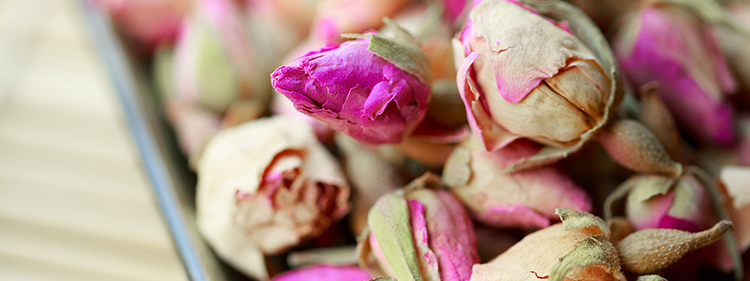
Culinary
As mentioned above, roses have an important role in the culinary industry as well. They can be used for a wide range of products from sweets to beverages and even some savoury dishes. You can enjoy the unique flavour of rose petals in your tea, you can add rosewater to your lemonade or your yoghurt, and you can make rose petal jam. Rose petals can be candied, they can be used as a flavouring, or made into delicious rose petal syrup that can be added to refreshing beverages, cocktails, and included in many recipes. Rose-flavoured ice cream is a popular treat in India, and kids from the United States can enjoy rose-flavoured marshmallows and scones. So, as you can see, if you’re a big fan of rose petals, you can easily fill up your pantry with delicious rose-based products.
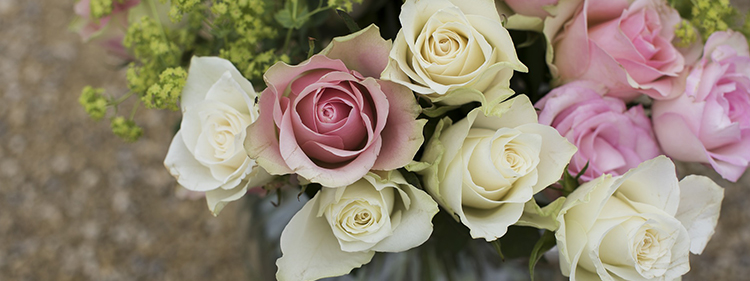
Home
Roses and rose petals can be used to make your home cosier and more inviting. A beautiful bouquet of roses will bring life and colour to your home, but there are other ways in which you can use these versatile flowers. If you have a rose garden, you can dry rose petals and use them as a homemade potpourri. For a stronger scent, you can combine them with other scented blooms such as lavender or thyme, with pieces of citrus fruits, or with spices such as cloves or cinnamon sticks. Other home products that can bring the nice smell of roses into your home include scented candles, incense sticks, and essential oils.
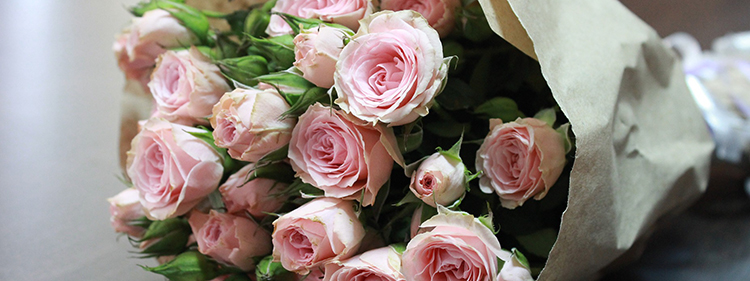
Know Rose Colour Meanings to Gift
Roses have been offered as gifts for centuries. Their beauty and their rich symbolism make them perfect gifts that never fail to impress. Different rose colour mean different things. So, before you decide to offer someone roses, it’s wise to become familiar with the different meanings and symbols that are associated with each rose colour.
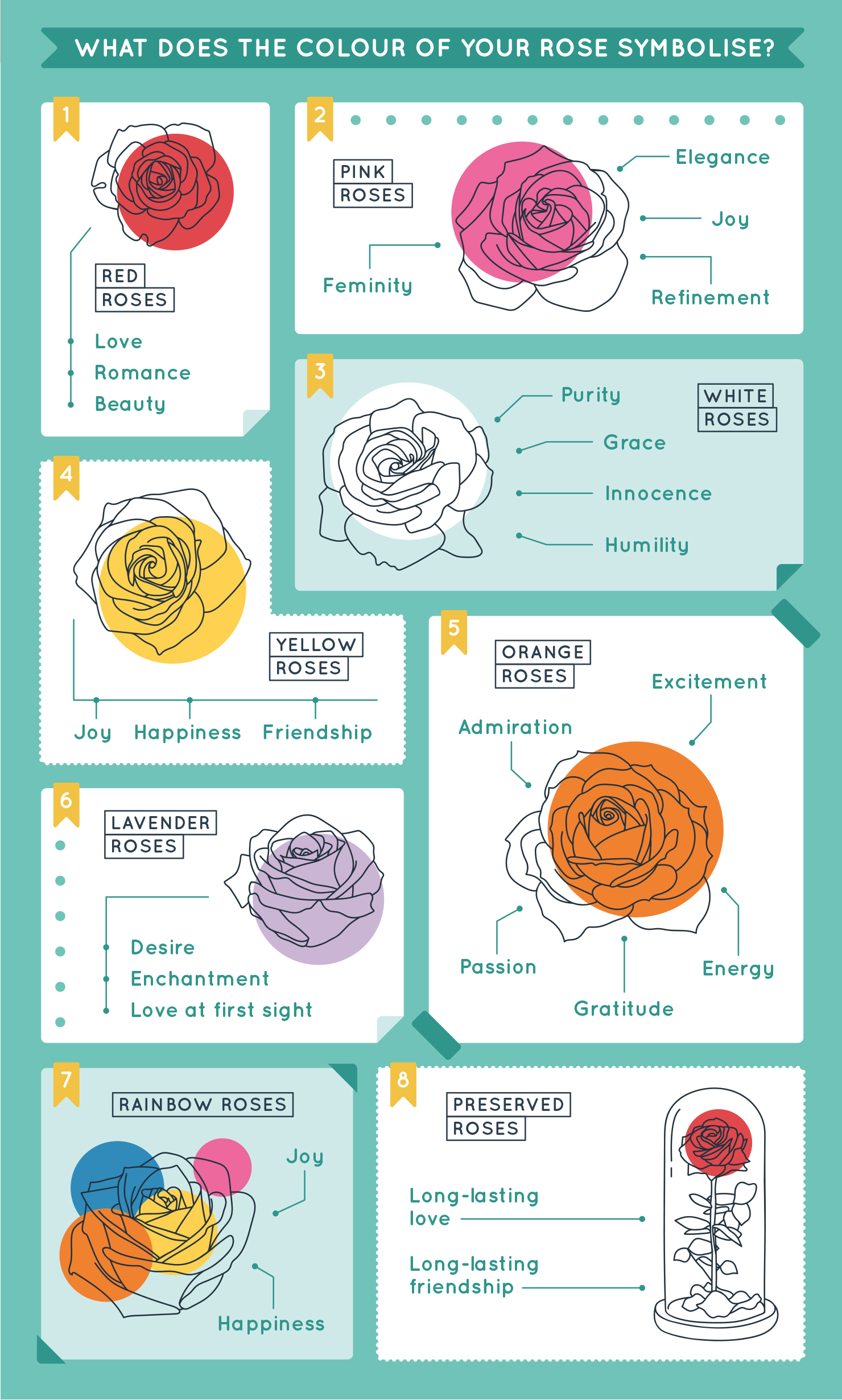
Red Roses
You are probably very familiar with what red roses symbolize. They are the most popular flowers that people choose when they want to express their love. Red roses are associated with Valentine’s Day and for a very good reason. They represent true love, romance, and beauty.
Pink Roses
If you want to show your appreciation for someone, pink roses are the best option. They are not as explicit as red roses, but they will still show that you care about a person deeply. Pink roses are symbols of femininity, elegance, refinement, and joy.
White Roses
In general, all-white flowers symbolise purity, grace, innocence, and humility and roses make no exception. White roses are a popular choice for weddings as they symbolise new beginnings and pure feelings.
Yellow Roses
People who love yellow roses are usually warm and kind. Yellow roses symbolise joy, happiness, and friendship. By offering yellow roses, you can show your affection sweetly and warmly.
Orange Roses
You can offer orange roses if you want to show your gratitude and to make an honest gesture of affection. Orange roses symbolise energy, excitement, and gratitude, but they can also symbolise passion and admiration.
Lavender Roses
This soft colour symbolises desire and love. If red roses are a bit too traditional for you and your loved one, lavender roses are the best alternative. In the language of flowers, lavender roses are also symbols of enchantment and love at first sight.
Rainbow Roses
Playful and unique, rainbow roses make unique gifts that will surely impress the recipient. If you want your bouquet to stand out, opt for rainbow roses and we guarantee that your gesture will not be forgotten.
Preserved Roses
Preserved roses are great gifts and their biggest advantage is the fact that they are long-lasting. A preserved rose will symbolise long-lasting love, long-lasting friendship, or something else, based on the rose colour that you choose. But regardless of the colour of the rose, your gift will also reflect your attention to detail and the fact that you prefer to offer something that will last for a long time.
How to Select the Right Rose for Your Garden
Although all roses are beautiful, they don’t all have the same needs. When planted in an unsuitable environment, a rose can be more susceptible to pests and diseases, produce small and poor blooms, and grow very slowly. As you already know, there are 6 different climate zones in Australia, which is why guaranteeing that a certain type of roses will thrive in your garden is a bit difficult. It all depends on your local environment. So, if you want your roses to thrive, it is important to consider a few key aspects: climate, location, and growth habits.

Climate
As mentioned above, a rose won’t thrive if the climate is unsuitable. As a general rule, climates with lots of humidity will make a rose more susceptible to fungal diseases. So, if you live in humid weather, make sure you choose a variety that is resistant to pests and diseases such as climbing roses, hybrid tea roses, floribundas, and grandifloras.
If, on the other hand, you live in a hot and dry climate, opt for rose varieties that have thick petals and leaves such as Orange Freedom, Iceberg, Earth-Kind, climbing varieties such as Lady Hillingdon, New Dawn, or Lady Baffin. If you live in a temperate climate, you’re in luck because this is the best environment for most types of roses.
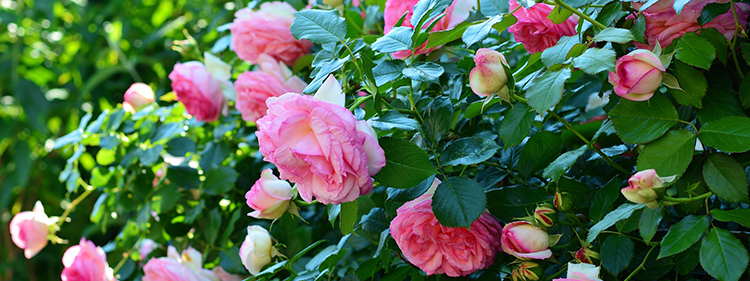
Location
Location can mean a lot of things such as the amount of space you have available, the amount of light that your plants will receive every day, the quality of the soil, etc. These are all important factors that can tip the scales in the favor of a more drought-tolerant variety or one that can withstand shade and humidity.
Another important aspect to consider when growing roses is the size of your garden and how much space your roses will have to grow. Because roses come in so many different shapes and sizes, you’ll surely find one that will thrive in your garden. If you have plenty of space that you want to fill, choose fast-growing roses that are tall and spread quickly. As a general rule, make sure you plant your roses at least 1 m apart. If your outdoor area is small, or if you want to grow roses on your balcony or in a container, we recommend opting for miniature roses.
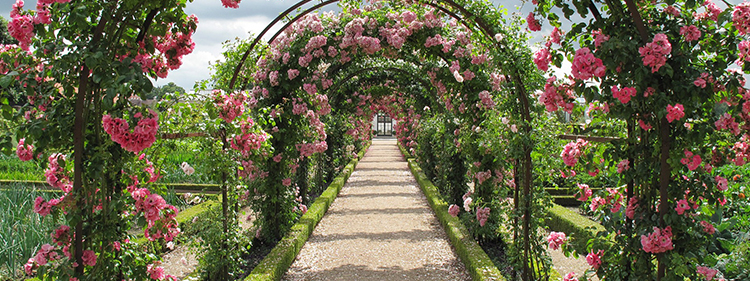
Growth Habits
Once you’ve assessed the local growing conditions and you know what type of roses you’d like to plant, make sure you check their growth habits and classifications. Understanding these details about the roses that you’re planning will make it easier for you to offer them everything they need to grow healthy and happy and to produce beautiful blooms.
Types of Roses Popular in Australia and World Wide
Is having a garden full of roses your biggest dream? If the answer is yes, then we recommend starting with the ones that have been known to thrive in Australian gardens over the past decades. Aside from their beauty, these roses will surprise you with their hardiness and ability to adapt even to harsh conditions.
But, as mentioned in the previous section, before you decide which ones you want to grow in your garden, always check the growth habits, the climate, and the growth conditions of your outdoor area.
It is important to mention that there are no native Australian roses. But, there are plenty of ‘Species roses’ that thrive in a wide range of habitats and that have been present in Australia since the 19th century. These single-petalled roses can be found in every corner of the world, from the northern hemisphere to Africa and the Middle East, and you can rest assured that they will do just fine without a lot of effort on your part.
Preserver and grow your roses
But that doesn’t mean that you shouldn’t try your hand at growing Old Garden Roses or Modern Roses. With so many varieties available on the market, it’s just a matter of picking the ones that are appropriate for your climate and that you want to see in your garden.
So, if you live in a hot and dry climate, a good starting point would be selecting a type of rose that thrives in this particular environment such as the Persian Yellow Rose (Rosa foetida persiana), China Rose (Rosa chinensis), Hybrid Tea Rose, etc. If, on the other hand, you live in a region with a temperate climate, you’re in luck because you can pretty much choose any type of rose. The only exception is Rosa rugosa a.k.a. the Beach Rose which is quite invasive and is a problem in many coastal regions.
That being said, let’s take a look at the varieties of roses that Aussie gardeners love the most.
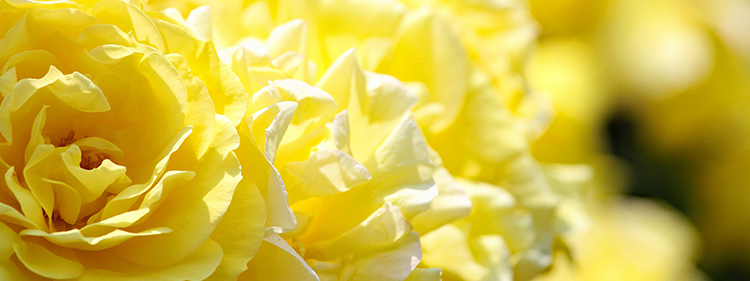
Floribunda Roses
Floribunda roses were created through a hybridization process from Polyantha Roses and Hybrid Teas. Gardeners love these roses because they produce big clusters of colourful flowers. Floribunda roses have a long flowering season, so if you plant them in your garden, you can enjoy their blooms for several months.
Although Floribunda roses don’t always have a notable fragrance, there are newer varieties that are more fragrant. The main advantage of Floribunda is the fact that they are more resistant to pests and diseases than Hybrid Tea Roses and more robust. This makes them a better choice for beginner gardeners.

Hybrid Tea Roses
When you think of the perfect red rose, you are probably thinking of a Hybrid Tea Rose. Hybrid Tea Roses are the most popular roses in the world and we like to think of them as rose royalty. For the majority of flower lovers, these roses check all the boxes: beauty, versatility, and fragrance. They produce a single bloom at the end of each stem, which makes them perfect for bouquets and cutting gardens. So, if you want to make flower arrangements and bouquets using the roses in your garden, Hybrid Tea Roses are a perfect choice. Hybrid Tea Roses are repeat-bloomers; their flowers are very large and reach, each having over 60 petals.
Thanks to the invention of Hybrid Tea Roses, people can now offer and receive beautiful bouquets of red roses that symbolize eternal love, such as our One Hundred Reasons bouquet.
They grow quickly, reaching maturity in three to four years and they come in all the colours imaginable, except blue. Why not blue? Because blue roses don’t actually exist in nature. Florists make blue roses by placing cut white roses in blue dye. In fact, changing the colour of a white rose is a really cool and fun experiment that you can try at home. All you need is a white rose and some ink or a sharpie cartridge. Some examples of beautiful Hybrid Tea Roses are Mr Lincoln, Peace, Friendship, Veteran’s Honor, Tropicana, Midas Touch, Garden Party, and Purple Passion.

David Austin Roses
Sometimes referred to as English Roses, David Austin roses were created by self-thought horticulturist by the name of David Austin. Mr Austin crossed old garden roses with modern roses and created over 200 different rose hybrids that received a lot of appreciation from rose growers worldwide. What makes David Austin roses so special is their diverse colour range, their ability to produce an abundance of blooms, their long-blooming period, and their ambrosial fragrances.
To this date, there’s 230 rose varieties created by David Austin. All of these roses are being sold across the world. Some of the most beautiful and fragrant David Austin roses are Claire Austin, Gertrude Jekyll, Gentle Hermione, Boscobel, Golden Celebration, Jubilee Celebration, Harlow Carr, Munstead Wood, Lady Emma Hamilton, The Generous Gardener, Scepter D’Isle, and Princess Alexandra of Kent. But the crown jewel of David Austin’s collection is the Juliet Rose. This exquisite peach rose with a deep, apricot heart is a generous, voluminous rose with an abundance of petals that are frequently used at very special events. It is also the second most expensive flower in the world, being sold for about $5000 on the black market.
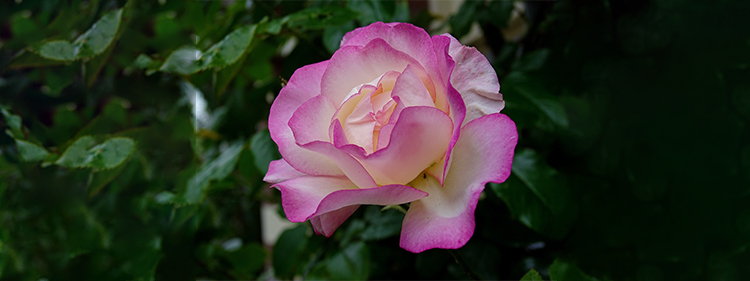
Grandiflora Roses
Introduced in 1954, Grandiflora roses are a variety of modern roses. Grandiflora is a cross between floribunda roses and hybrid tea roses. They produce clusters of flowers on top of tall stems and their main advantage is the impressive size of their blooms.
Grandiflora roses are quite tall. Reaching up to 2.5 meters in height, they can be used to create living borders and screens. Grandiflora roses have a nice scent and they thrive in full sun. Some of the most popular varieties of Grandiflora roses are Earth Song, Maria Shriver, Octoberfest, Honey Dijon, Dick Clark, Queen Elizabeth, Scarlet Knight, and Radiant Perfume.
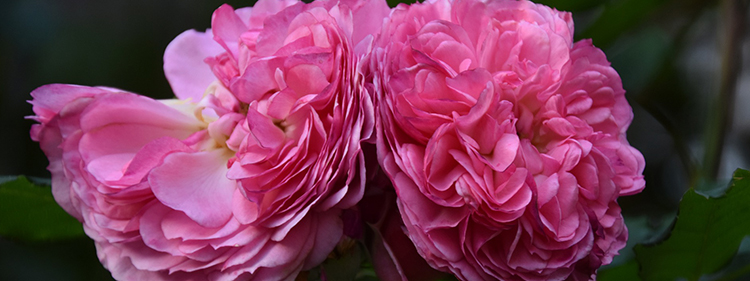
Damask Roses
Rosa x Damascena, commonly referred to as Damask rose or Rose of Castile is an old rose and a very special one. It is a hybrid created by crossing Rosa gallica and Rosa moschata and its flowers are extremely appreciated for their lovely fragrance. There are two main varieties of Damask rose: Summer Damask (blooms in summer and has a short flowering period) and Autumn Damask (blooms through summer and autumn and is more popular thanks to its long flowering period).
Damask roses are cultivated worldwide. They are then used in the production many things. Such as perfume, rose oil, rose water, and rose concrete (a semi-solid, waxy material, with a strong fragrance). The petals of Damask roses are edible and you can use them to make tea, confiture, gulkand, rose jelly, and all sorts of sweets.

Climbing Roses
Climbing roses are also very popular, especially among gardeners who love cottage style gardens and English gardens. You don’t have to have a specific style when bringing these beauties to your outdoor area. Climbing roses are a perfect way to make your garden seem more lush and abundant. You can attach them to house walls, trellises, arches, pillars, obelisks. You can use them to hide different things that you find unattractive.
Most climbing roses produce large flowers that grow in small groups or singly and most of them are repeat-bloomers. This means that you’ll get to enjoy them throughout the warm season. Want to know the most attractive and popular climbing roses? These are Climbing Tea Roses, English Climbing Roses, Bourbons, Noisette, Claire Austin, Iceberg, Constance Spry, and Gertrude Jekyll.

Rambling Roses
If climbing roses are not for you because you are currently on the lookout for beautiful shrubs. Consider rambling roses are a perfect choice. Rose shrubs are commonly known as rambling roses. Rambling Roses can support themselves better than climbing roses. They can also be trained to cover pergolas, arches, and other objects. They can grow bigger than climbing roses because they are very robust and have strong, vigorous stems. When you start growing rambling roses, make sure you choose a location where they have enough space to grow.
A notable difference between rambling roses and climbing roses is their blooms, which in rambling roses are small and abundant. Climbing roses, as mentioned in the previous paragraph, produce large flowers that are sometimes clustered and sometimes single. Additionally, rambling roses will generally bloom once per season. However, you’ll be amazed by the cascade of flowers. Followed by attractive hips, which persist in autumn and winter.
Tough and robust, rambling roses can thrive in poor soil, heat, partial shade, and they are quite pest-resistant. Our favourite rambling roses are Rosa ‘Wedding Day’, Rosa ‘The Albrighton Rambler’, Rosa ‘Super Fairy’, and Rosa banksiae ‘Lutea’.
Ground Cover Roses
You might be surprised to learn that roses can also make great ground covers. Ideal for growing in garden beds or containers. Ground cover roses are perfect for places that are a bit tricky to garden and to maintain. Many varieties of ground cover roses are resistant to pests and diseases and thrive in many different types of environments. These trailing perennials have a long flowering period and can even be used to suppress weeds.
Most ground cover roses thrive in sunny spots and well-drained soil. However some varieties are quite adaptable and won’t mind partial shade. The most popular ground cover roses are Rosa Flower Carpet, Rosa ‘Grouse’, Rosa ‘Worcestershire’, Rosa ‘Nozomi’, and Rosa ‘Surrey’.
Unique Roses

Miniature Roses
Miniature roses are our favourite flowers. They have been created through selective breeding and they come in a huge variety of colours. They are absolutely adorable and are extremely hardy and easy to grow and to care for. As you might have guessed, miniature roses are much smaller than regular roses. A miniature shrub rose usually being 25-30cm across. Their size makes them perfect for balconies, small outdoor areas, containers, and you can even grow them indoors.
Although you might be tempted to think that their small size makes them more sensitive to harsh weather. It’s quite the opposite. Miniature roses are more resistant to cold weather and they are all repeat-bloomers.
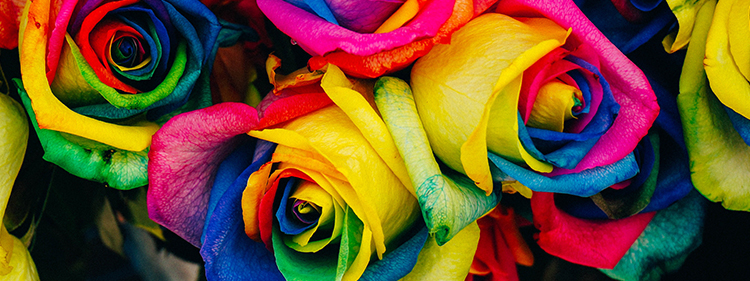
Another unique type of rose that you’ve probably seen on Instagram and might be curious about is the rainbow roses. Rainbow roses don’t naturally grow like this. Their petals are artificially coloured. This is done by splitting the stems and putting each piece in a container filled with water that has been coloured with dye. But the fact that they don’t naturally grow like this doesn’t make them less beautiful than natural ones. Rainbow roses make unique and surprising gifts. Anyone who loves rainbows will surely be impressed by such a thoughtful gift.
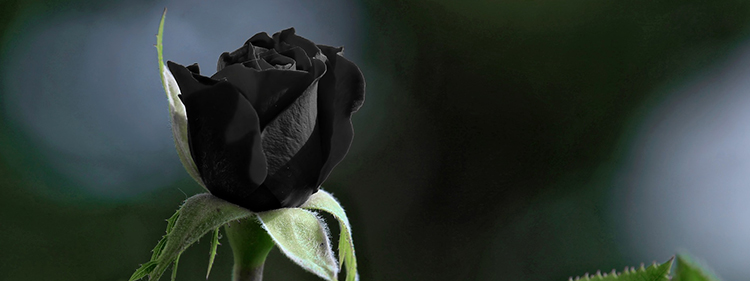
Black Roses
With their unique appearance, black roses are extremely elegant and popular. Especially for people who have a passion for the gothic look. But, interestingly enough, black roses aren’t actually black. They are a very dark shade of purple, burgundy, or maroon. Which you can easily notice by looking at them under bright light. If you’re a fan of dark coloured roses, there are many varieties that you can choose from. Colours such as Black Magic, Black Baccara, Black Beauty, Black Cherry, Black Ice, or Black Jade.
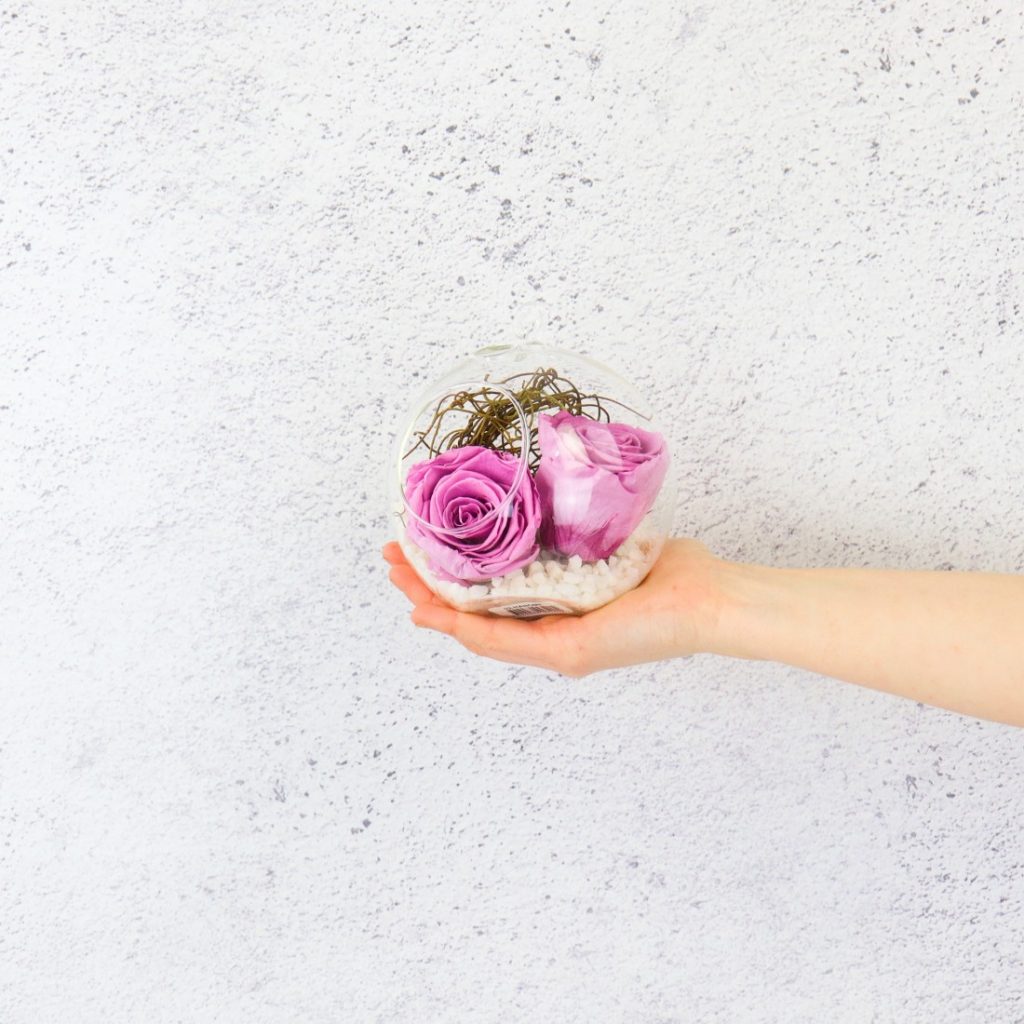
Wondering what exactly is a preserved rose? It’s quite simple. A preserved rose is a regular rose that has been prepared in a certain way to become everlasting. The process is eco-friendly and the results are spectacular. You can find out more and purchase your very own orb here.
Preserved Roses
More and more people are looking to offer long-lasting flowers and preserved roses are a great option. However you may not be a big fan of offering a gift that will wither in a few days. If so, you should consider replacing the traditional bouquet with a preserved rose.
Another great advantage of preserved roses is that they don’t need any water or sunlight. Therefore they can be kept on a bookshelf or in a decorative vase and will look alive for up to three years.
Roses FAQ
Question 1: Where do roses grow best?
Answer: Most roses thrive in temperate regions. Big lovers of sun and well-drained rich soil. Roses are among the most versatile of garden companions in terms of growth conditions. As long as they are planted in a location where they will get 6 hours of sunlight every day. Roses will be grateful and reward you with their beautiful blooms. If you don’t live in a temperate region, don’t worry! There are plenty of rose varieties that will thrive in other types of climates as well.
Question 2: What are the easiest roses to grow?
Answer: The easiest roses to grow are those that are fully adapted to your local environment. As well as those that are pest and disease resistant. Some of the hardiest roses available on the market are Knock Out, Earth-Kind, Hybrid Perpetual, Polyantha, Rugosa. As well as the climbing and rambling varieties.
Question 3: What is the best month to plant roses?
Answer: It’s best to plant roses in spring or fall. If you decide to plant your roses in spring, make sure that the danger of frost has passed. If planting in Autumn, it’s best to plant them early to ensure that their roots are fully developed. This way the plants are safe during the cold winter months. So, the ideal months to plant roses in Australia are probably October and November for spring planting. March and April for autumn planting.
Roses are truly amazing flowers and friendly garden companions. Growing them in your garden is a rewarding experience. They will produce beautiful blooms that you can turn into delicious syrups, jams, and even homemade rosewater. Can’t grow roses at home? No worries! You can still enjoy these precious flowers by treating yourself to rose-based products. Alternatively by filling your home with beautiful bouquets of roses.
Are you currently looking for a beautiful bouquet of roses to surprise someone you love? We offer a wide range of rose bouquets, from traditional red to unique rainbow roses.

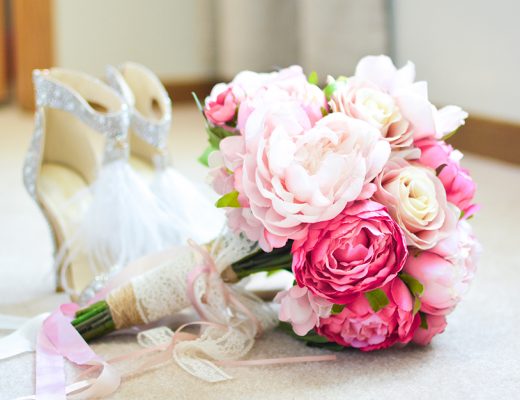
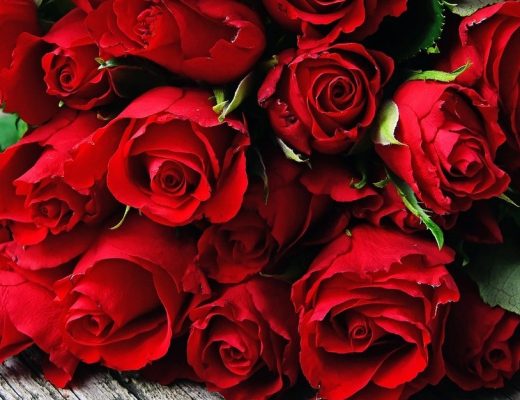
No Comments